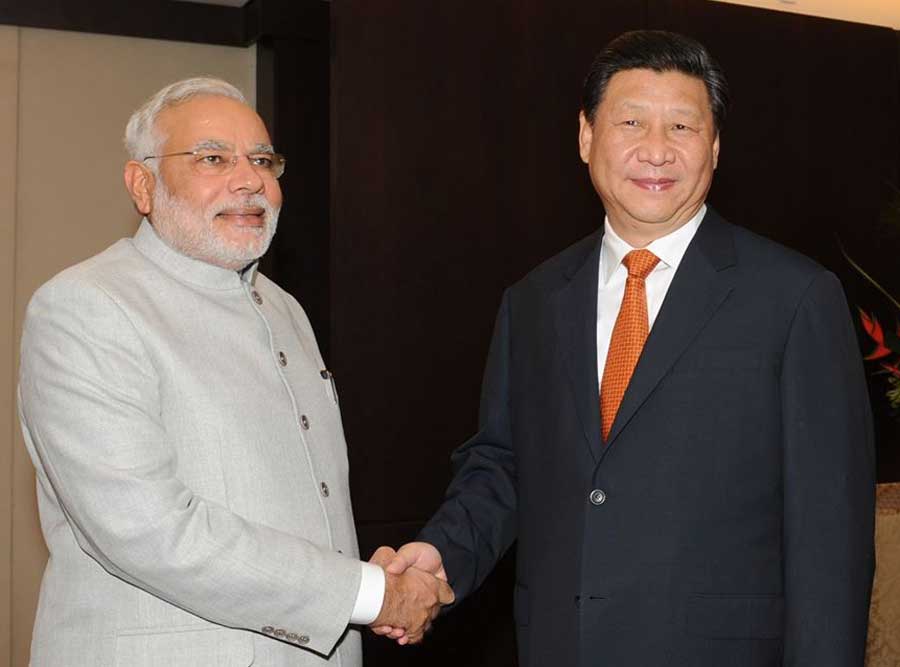IDR Blog
Xi Jinping on Modi's Turf: A Strategic Perspective
Xi Jinping will embark on India’s visit starting from Gujarat on 17 Sep 2014. The visit comes at the heels of just concluded Modi’s Japan visit. Long predicted Asian age has signaled its arrival. As the world’s economic giants try to woo India, she continues to hold the cards close to her chest. Soon after Xi’s visit Indian Prime Minister leaves for US where Obama waits for him with a red carpet. And it’s not over, thereafter India prepares to greet Putin at the Lutyens Delhi in December later this year. The agenda is economic as it appears however good sense of geo-politics in the contemporary times is guided by economic interests. The geo-strategists view territorial expansionism witnessed in previous centuries as an outdated concept now steered by geo-economics which is the order of the day.
While India has a capacity to generate up to two trillion US dollars, the remaining shortfall has to be managed largely through the investments from US, China and Japan.
India needs massive investment in infrastructure and developing its manufacturing potential. Modernisation of Indian railways, construction of highways, power generation and distribution, irrigation, ports, and manufacturing are a few areas that awaits deployment of large proportions out of whooping 4 trillion USSD Chinese foreign currency reserves. World watches carefully as the two giants meet.
While the Chinese are yet to come to terms with historical humiliation at the hands of Japanese during WW II, the Indians grapple with the scars of 1962 military defeat on the Himalayan borders. The unresolved border dispute with the Chinese is a constant reminder of the acrimony between the two giants. Japan on the other side is locked in bitter maneuvers for dominance of South China Sea and India not lagging much behind in carving its role along with Vietnam.
The co-ordinates of geo-economics that would drive our future must be plotted well to have a better understanding of the contemporary geo-politics. A run over the environmental scan will highlight the strategic space, voids, convergence and compulsions available to these two Asian gaints.
Recently at a seminar in New Delhi that I attended in June on the future prospects of Indo-Japanese economic co-operation, ex industry minister Mr Suresh Prabhu underscored the enormous Indian appetite in next decade for developing our infrastructure. He stated that India would require anywhere up to five trillion US dollars to make the envisioned growth and development story manifest for real. While India has a capacity to generate up to two trillion US dollars, the remaining shortfall has to be managed largely through the investments from US, China and Japan. I wish it was an easy zero sum game which unfortunately is not so. India is desperate to for investments and no economy would like to miss out on this opportunity. India is finally proving herself to be the swing state for world economies. She holds the key for their future over this century.
For US the frontlines have shifted to the Middle East. The next decade will see the west jostling with ISIS bringing instability to the region at a scale not yet calibrated.
Chanakya once said that “There is some self interest behind every friendship and there is no friendship without self interest”. The Indian interests to her east may be clashing in the west with same set of players. The US, Japan and Australia want India to be part of the Asian pivot in countering Chinese expansionism in South China Sea and the Pacific but India on the other hand may not like to surrender its strategic autonomy so zealously guarded over past decades.
Nevertheless harsh realities of world politics has made India gradually drift away from Nehru’s idealism to Modi’s realism. The recent indicators to this shift can be gauged by the take away from Indian Prime Minister’s visit to Japan and later a short nuclear visit by the Australian Prime Minister this month. India has managed to scale up its relations with Japan to the status of Special strategic partners. Riding over commitment of USD 35 billion investments over next 5 years for development projects and enhanced co-operation in defence and other strategic areas India has ensured this relationship moving altogether to new levels.
Charting the future of India-Australia relations, the recently concluded civil nuclear agreement can be seen as a shift in focus the way India now figures in the matrix of foreign policy of Australians. For decades they had focused in Asia Pacific region notably Japan, South Korea, China and other members of ASEAN. India stood nowhere since economic, political, religious and cultural diversity kept the Australians ever elusive from developing ties with the countries in the south eastern edge of the Indian Ocean rim. This Ocean of neglect is not so any more now.
The hegemonic Chinese designs in the South East Asian region coupled with economic compulsions have brought US, Japan, Australia and some ASEAN countries into a deeper co-operation with India. While there is convergence in the east, divergence in the region west of India are too many. The strong presence of the Indians in the middle east and our dependence on the Arab oil makes India vulnerable to the policies perused by the west in the region. Forced regime changes and armed interventions by the western nations do not go well in safeguarding our interest in the region. Above all the US and its allies over the years have supported Pakistan economically and militarily at the cost of our security concern which is all well known. Chinese helped Pakistan in developing nuclear weapons clandestinely while the US looked the other side is an open secret.
The Chinese investments will not be hostage to the ongoing border dispute however an early resolution is a must for mutually respecting relationship between the two nations.
The things are changing for this frontline state of cold war and global war on terrorism era rather too fast than anticipated. A scenario post draw down of US troops from Afghanistan by the year end has brought US, China, India and Russia on the same page in tackling the new emerging situation. Interestingly all these countries suffer at the hands of terrorists churned in the terror nurseries located in Pakistan. Preventing resurgence of Taliban and Al-Qaeda in Afghanistan is a major challenge confronting these countries.
For US the frontlines have shifted to the Middle East. The next decade will see the west jostling with ISIS bringing instability to the region at a scale not yet calibrated. Pakistan will now be the carefully watched eastern flank in this new war and very much under the cross hair.
On the other side, Putin is trying to seek new market for its hydrocarbon reserves to counter the western sanction awarded for his involvement in Ukraine. Recently Russians have proposed an energy corridor connecting oil and gas fields of central Asia to India through China.
It makes a larger sense for the Chinese to unlock its relations with India. All the economic activity of the two countries in Afghanistan and CAR is stalled by the constant threat from India specific LeT and Chinese ETIM separatists from Xinjiang province. These terrorists have safe havens in the tribal belt of Pakistan bordering Afghanistan. Afghanistan and CAR region thus presents itself as a workable strategic space for co-operation between the two countries.
The defence apparatus of our country needs to be strengthened many folds before any such display of confidence.
The Chinese investments will not be hostage to the ongoing border dispute however an early resolution is a must for mutually respecting relationship between the two nations. But the history cannot be brushed aside either. Lot has changed since the visit of June 1954 by Chou-En-Lai who repeatedly talked to Nehru about India being economically and industrially more advanced than China. Nehru called this visit of great historic significance. He said it was coming together of India and China which is a major event Asia and perhaps the world. The self deception thus created in the mind of Nehru and his government was so strong that they chose to neglect the defence of India against the lurking Himalayan despite numerous warnings.
Indian Prime Minister during his Japan’s visit may have boosted morale of our nation by a veiled attack on the China’s expansionist policies and coupled with this the go ahead given by his government to the stalled developmental projects along the LAC Ladhak may have strengthened the resolve. But a word of caution, don’t prick the dragon so soon. The defence apparatus of our country needs to be strengthened many folds before any such display of confidence. As I write there is a reported PLA intrusion in Demchok area of Ladhak and this comes just two days prior to Xi’s visit. I am sure the wise men at the helm of affairs will not get easily enamored by Xi Jinping’s overt display of wealth and promises of development walking straight in to the Chou-En-Lai trap.
Post your Comment
2 thoughts on “Xi Jinping on Modi’s Turf: A Strategic Perspective”
 Loading Comments
Loading Comments





Economic interdependence is the name of game. Let India play its role as a win win partner and get stronger. Survival for the fittest requires India to become economic giant using its 65% young population desperate to look for employment.
In the same way as the Chinese have not allowed their economic engagement with Japan to get bogged down by historical baggage, India should also not let the ghost of 1962 affect our economic agenda. And mind you, the ghost is weighing only upon the Indian psyche; the Chinese have left it far behind.
Economic inter-dependence is the biggest bilateral safety arrangement. The border issue virtually has no relevance here. And here India needs to work upon correcting the huge trade imbalance.
And there is no trap either. The border dispute is equally of India’s making too. It is unfair to expect China to quietly accept the British imposed MacMahon line as the border. India needs to think out of the box here. I am sure the Chinese will reciprocate in more than equal measure.